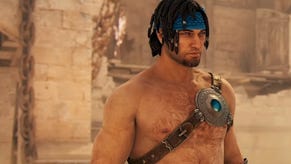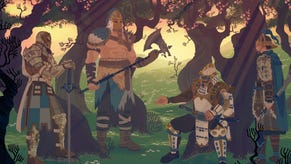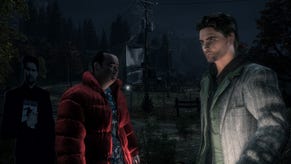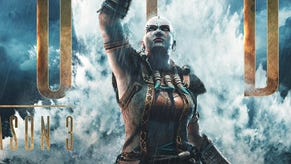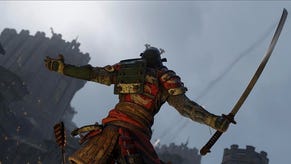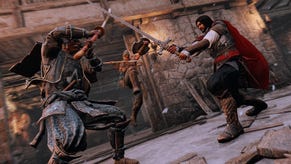For Honor re-review - a troubled wargod finally gets into its stride
Parry on ganking.
Sometimes the best parts of a game aren't where its heart lies. If you want to experience For Honor in its prime, make a beeline for duels. Here, you're free to savour the meaty wonderment of the game's weapon-based combat system without distraction, away from the chaos of the team-based modes. A quick overview of the basics, for newcomers: fighters switch between left, right and top stances to launch or block attacks from those directions, as indicated by a three-segment shield icon. Each move burns stamina, and draining the bar will leave you as helpless as a kitten, so knowing when to ease off and catch your breath is key.
A year on from release, the system remains a terrific reworking of concepts familiar from 2D fighting games, spiced up with presentational elements from shooters - all the guard breaks, zoning, feints and psychological war of a Soulcalibur, fed through Gears of War's over-the-shoulder camera. Duelling is where the game really sparkles, where the beautifully animated movesets of its vikings, knights and samurai warriors are easiest to dissect and master. It's also where the game is most civilised, with players often apologising for hoofing you into each map's plentiful terrain traps, and thanking each other like grown-ups after a hard-fought encounter. But it isn't where the heart of For Honor truly lies.

That would be in Dominion mode, a 4v4 mashup of Battlefield's Conquest mode and the MOBA which swamps the finer points of swordplay in streak rewards and unrelenting ganking. Here, teams duke it out over three capture points, one suffused with NPC creeps who can be farmed to fuel secondary abilities or "feats". Capturing bases fills up a points bar, and when one team hits a thousand points, the other team can't respawn till it has wrestled back some territory. Where duels are often sportsmanlike affairs, here there is no fairness and no mercy. In Dominion you'll scientifically dismantle a cornered knight, only for three other knights to rock up behind and kick you around like a traffic cone while your victim flees to safety. In Dominion, you'll regroup on an objective, ready to reclaim the lead, only for the other team to wipe you all out with a ballista strike rather than killing you hand-to-hand.
Dominion is, in theory, anathema to For Honor, a moshpit slapbang in the middle of a fencing tournament. It was also especially badly affected by Ubisoft's decision to use P2P networking at launch, a misfire that has belatedly been rectified - playing the PS4 game on dedicated servers all last week, I've experienced only a couple of connection losses and some infrequent, minor latency. But together with the other 4v4 modes - Skirmish, TDM and round-based Elimination - it's the mode that has kept this bizarre faux-historical brawler alive during its wobbly first year, attracting the highest player counts where duelling has become the preserve of a strutting aristocracy. And it's actually a hell of a lot of fun, once you acclimatise to the extra pressures, the primary rule of thumb being to leg it or stall for time when you're outnumbered. Dominion is essentially a series of duels without tedious intermissions, for one thing, and the ambience of battle is well-captured, from the throng of yelling NPCs in the centre of each map to the ominous fanfare when one side runs out of respawns.
The gulf between Dominion and duelling is one of For Honor's defining contradictions. This is a multiplayer game that aims for both precision and breadth, daunting finesse and rough-and-tumble, sociable sprawl. It's come a long way since its seismic launch and rapid decline in popularity last year, though not quite as far as 2016's Rainbow Six: Siege, another PvP oddball which now regularly makes the top three most-played games on Steam. Ubisoft has added a fully fledged tutorial component on top of the existing sturdy bot support - a series of trials that score you on your mastery of fiddlier techniques, and a proper solo arena option where you can pick enemy heroes and flag up the combos you want to learn. There's also a new multiplayer mode, CTF variant Tribute, in which players tussle over standards that bestow power-ups; the secret crucial dynamic here is actually the absence of NPC creeps, which makes it hard for some classes to charge up their feats. None of this has set For Honor's fortunes alight, but after the stumbles of year one, it feels like this tremendous, eccentric brawler is at long last making some headway.
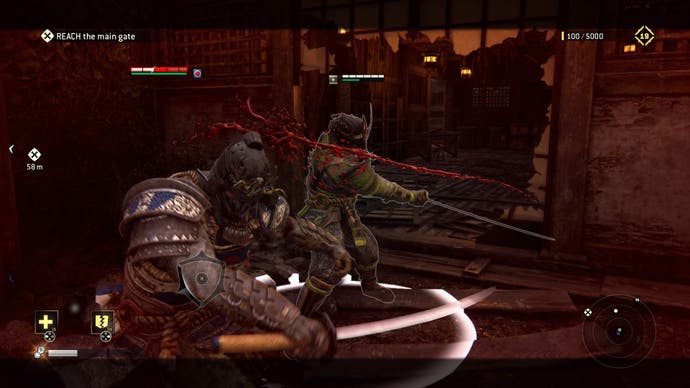
The game's biggest downside - boring, thrown-together campaign mode aside - continues to be its quintessentially Ubisoft addiction to fussy interface design and monetisable swag (an overdue mea culpa: I didn't pay nearly enough attention to these elements in my original review of the game). For Honor's action may be sharp, but the UI and menus are a quagmire of currencies, ranks, XP boosters and incremental randomised rewards. Finish a battle, and you'll be drowned in loot notifications and gobbets of bonus XP from "Orders" or micro-assignments, such that I still occasionally forget where the "next match" button is. New characters and cosmetic options such as emotes can be unlocked with an in-game currency, Steel, or bought with real money. Faced with a backlash at launch, Ubisoft has accelerated the initially sluggish earning rate for Steel to counter accusations of bullying people to pay extra for content. Many dedicated players seem happy with the result, but this remains a grindy experience, with many hours necessary to unlock each character in PvP, especially if you opt for the cheaper Starter Edition.
On top of the tatty customisation and progression elements sits the Faction War, a subgame whereby match victories and each player's deployment of "war assets" change the balance of power on a multi-region overworld. The map updates every six hours to show which of the three campaign factions controls which regions, and resets every few weeks after declaring an overall winner. The idea is to foster a sense of loyalty towards a faction and thus, strengthen your commitment to the game as a whole, but I struggle to care when the effects of the war are so negligible. It basically comes down to some gear pieces and a few cosmetic flourishes on maps - the banners you'll see on walls, or which faction's soldiers are visible in Dominion's opening cutscenes. For all that, the mode is extremely popular: check the various community threads, and you'll find no shortage of arguments about faction strategy and allegations of rigging. If the appeal is lost on me personally, Ubisoft does seem to have crafted a valuable narrative context for the clownish personas of the heroes themselves.

There are now 18 of the latter, including six DLC characters, evenly split between skill levels and styles. For Honor's roster was pretty mighty to begin with, and the new faces are great additions to the mix. The Centurion is a boulder of a man with a tiny sword and startlingly fast hands - he's about closing the gap fast and brutalising you with stabs and straight punches. The ambidextrous Aramusha is more of a surgeon, equipped with a special cross-blade parry that lets him segue quickly into a spinning kick or an infinite slashing combo. Though ostensibly a meathead like the Raider, the Highlander requires a lot more finesse thanks to his split moveset, either wielding his massive claymore with both hands to defend, or holding it in one fist to perform unblockable swings. While too slow and short on follow-through to carry a melee, he's a community favourite for his bellowed catchphrase "Dun Mah Glass". It roughly means "for my castle!", though Redditors point out that in French, it sounds a lot like "give me my icecream!" I feel this captures the spirit of For Honor far better than any actual dialogue in the game.
The Shaman is rather deadlier, a maddening flea who'll pounce on you axe-first, then ding you with a dagger that lets her regain health for every subsequent hit and, assuming she times the next leap just right, pin you down and bite your ear off. She's a real terror in a crowd, easy to lose track of thanks to her relatively low profile. The Gladiator is a newbie option, built around quick prods, surprise hooks and sticking people in the gut so you can shovel them about like a pile of hay. And the Shinobi, finally, likes to backflip out of trouble and harass people with his throwable chain sickles, at least till somebody catches one and yanks him off his feet.
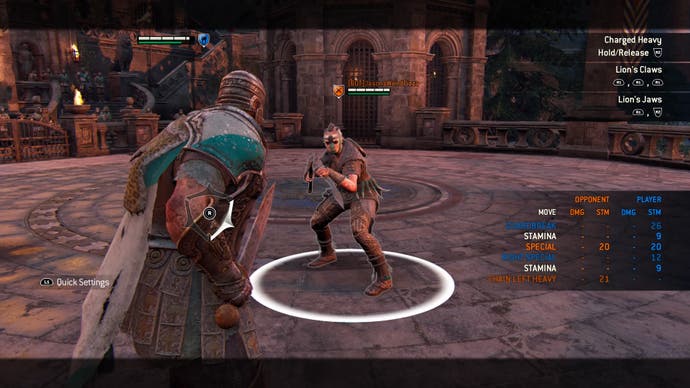
Finding the balance of power between characters has been something of a journey for Ubisoft, perhaps a longer journey than is healthy for a fighting game. The springy, spear-wielding Valkyrie, an early favourite of mine, has oscillated from wet blanket to wrecking ball and back again in the course of several updates. The assassin Peacekeeper still needs the attention of the nerfgun, wriggling out from under combos that would decimate other heroes and seldom letting you wriggle away from her in turn.
More seriously, the feats in 4v4 are a little open to abuse, or at least to tactics that make the game less fun for others. Certain combinations of self-buffs are hard to counter, and there's an aggravating tendency to finish off those 4v4 matches using AOE feats - a rude splash of Call of Duty in a game that is generally at its best when you're dragging out those encounters. I'd appreciate a 4v4 playlist that disables gear advantages and feats; Ubisoft's refusal to add one is somewhat mystifying. The general sense, though, is of a project with its heart in the right place, introducing new elements while responding to community requests. One particular update from February has quietly transformed the game: you're no longer guaranteed a guard break when you parry, which makes turtling much less effective. It means that 1v1s are more about rallies, more of a conversation, and less about baiting your opponent into swinging first.
For Honor remains one of my favourite games of 2017, warts and all. I've been sad to see it fade from view, as dodgy networking and pushy monetisation have driven off players enticed by the thought of a truly technical fighting game that dresses like a third-person shooter. It's fantastic, then, that Ubisoft has decided to stick with it. The addition of dedicated servers was more than I was expecting this long after launch, and the new tutorial elements are obviously evidence of a belief that the game's community has plenty of room to grow. If you've been holding off, circling the fray with your shield up, there's never been a better time to get up close and personal.



